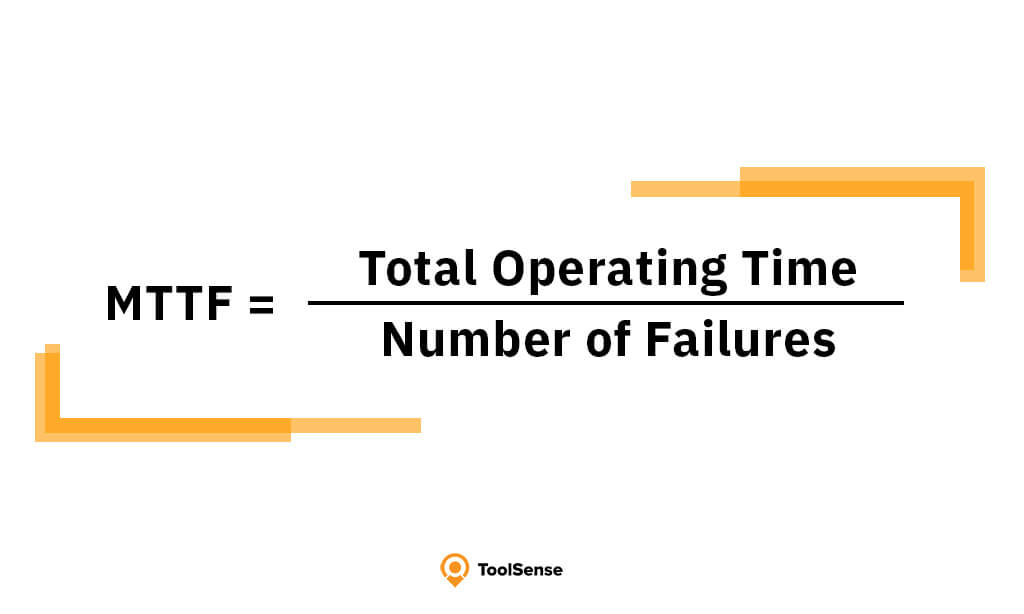Mean Time to Failure (MTTF) is a crucial reliability metric used in various industries, including aerospace, construction, automotive, manufacturing, and electronics. In this glossary post, we will define MTTF, explain how to calculate it, discuss its applications in various industries, and outline related concepts such as Mean Time Between Failures (MTBF), Mean Time to Repair (MTTR), and Availability. Additionally, we’ll highlight the importance of understanding MTTF for optimising maintenance schedules and reducing downtime, and how an asset management solution such as ToolSense can help improve these vital metrics.

Key Facts
- MTTF is an important reliability metric, along with MTBF (Mean Time Between Failures) and MTTR (Mean Time To Repair).
- Mean Time To Failure is calculated by dividing the total operating time by the number of failures.
- Tracking and improving important reliability metrics such as MTTF can help a company increase an asset’s lifespan, boost productivity and profitability, as well as reduce maintenance costs.
- ToolSense’s asset management solution can be used to automatically track and collect important data to improve not just MTTR, but the entire asset management strategy.
What Is Mean Time to Failure (MTTF)?
Mean Time to Failure (MTTF) refers to the average time it takes for a system to fail. It is an essential metric for reliability analysis, as it provides a quantitative measure of how long a non-repairable system can be expected to function before it fails. MTTF is calculated by dividing the total operating time by the number of failures during that time.
ToolSense is trusted by 700+ companies



Situations When Calculating MTTF Can Help Improve an Organisation’s Asset Management Strategy
Calculating MTTF can be extremely beneficial for organisations looking to improve their asset management strategies. One key area where MTTF can be useful is in the purchasing of equipment and parts. By understanding the MTTF of different products, companies can make more informed decisions when acquiring new equipment and parts. For example, if one product has a significantly longer MTTF than another, it means it has a potentially longer asset lifespan, and it may be more cost-effective in the long run to purchase the product with the longer MTTF, even if it has a higher upfront cost.
Another area where MTTF can be useful is in maintenance scheduling and improving maintenance operations. By knowing the average time it takes for a product to fail, organisations can schedule maintenance before a failure occurs, reducing downtime and improving productivity. For example, if the MTTF of an asset is 500 hours, a company may schedule maintenance every 400 hours to reduce the risk of failure and prevent downtime.
Finally, MTTF can also be beneficial in inventory control and inventory management. By understanding the MTTF of different products, organisations can better manage their inventory and reduce the risk of stock outs. For example, if a product has a short MTTF, it may be beneficial to keep more of that product in stock to ensure that the company always has a sufficient supply.

How to Calculate Mean Time to Failure?
To calculate MTTF, you need to track maintenance metrics and collect data on the operating time and failure rate of the product or system. The Mean Time To Failure formula is:

However, there are some assumptions and limitations to be aware of when calculating MTTF. For example, MTTF assumes that failures are independent and identically distributed, which may not always be the case. Additionally, MTTF does not consider the severity of the failure or the consequences of the failure. Mean Time To Dangerous Failure metrics might look different to general MTTF metrics.
MTTF Calculation Example
In a Mean Time To Failure example, a system is running for 500 hours and experiences 4 failures during that time. According to the Mean Time To Failure equation, the calculation would look like this:
MTTF = Total operating time / Number of failures
MTTF = 500 / 4
That means this particular system has a Mean Time To Failure of 125.
MTTF: Industry Examples
MTTF is used in various industries, and it has a significant impact on product reliability optimisation and maintenance planning. In the aerospace industry, MTTF is used to estimate the product lifespan of aircraft components and optimise maintenance schedules. MTTF is also essential in the automotive industry, where it’s used to evaluate the reliability of car parts and improve design and manufacturing processes. In the electronics industry, MTTF is utilised to estimate the lifespan of computer components and optimise maintenance schedules. In general, MTTF is useful for any company that aims to reduce unplanned downtime, asset failure, and general maintenance costs, as well as improve their preventive maintenance schedules and predict system failures.

Related Concepts: Mean Time Between Failures (MTBF), Mean Time to Repair (MTTR), and Availability
MTTF is closely related to other reliability metrics, such as Mean Time Between Failures (MTBF) and Mean Time to Repair (MTTR) as well as Availability. MTBF refers to the average time between failures, while MTTR refers to the average time it takes to repair a failed product or system. Availability is a measure of the percentage of time a product or system is available for use. These metrics are all used to evaluate system reliability and optimise maintenance procedures.
Importance of MTTF and How ToolSense Can Help
Understanding MTTF is crucial for improving maintenance schedules, reducing downtime, and optimising product reliability. In the long run, this will lead to higher productivity and profitability. However, the key to reaching these company goals is collecting vital data, such as MTTF and other reliability metrics, and using them to make more informed decisions. Asset management software like ToolSense can help companies with real-time monitoring, predictive maintenance, and automated alerts. Important data, such as runtime, equipment downtime, maintenance history, and work orders, are collected automatically and displayed as useful analytics on the platform’s customisable dashboard. The information maintenance teams need to work more efficiently is available at any time.
How to Improve MTTF
Improving Mean Time to Failure (MTTF) can help organisations achieve higher levels of productivity and profitability by reducing downtime and increasing reliability. But what are the top 3 ways a company can improve their MTTF?
1. Purchase quality materials and parts
One of the most effective ways to improve MTTF is by purchasing high-quality materials and parts. By using materials and parts that are designed for durability and reliability, organisations can improve the MTTF of their products and reduce the risk of failure. While high-quality materials and parts may have a higher upfront cost, the long-term benefits of improved MTTF can outweigh the initial investment.
2. Use assets only for intended functions
Another way to improve MTTF is by using assets only for their intended functions. Misusing or overusing assets can increase wear and tear, reducing the MTTF and increasing the risk of failure. Organisations should ensure that their employees are properly trained on how to use non-repairable assets and that they are using them in an intended manner.
3. Implement an effective preventive maintenance program
Finally, an effective preventive maintenance programme can significantly improve MTTF. Regularly scheduled maintenance can help identify potential issues before they become serious problems, thus reducing downtime and improving productivity. Additionally, preventive maintenance can help extend the lifespan of assets and reduce the need for costly repairs or replacements.
Conclusion
Mean Time to Failure (MTTF) is a critical metric for product reliability and asset management. By understanding how to calculate MTTF, its applications in various industries, and related concepts such as MTBF, MTTR, and Availability, companies can optimise their maintenance schedules and reduce downtime, ultimately improving their overall productivity and profitability.
MTTF provides a quantitative measure of product reliability and is used to estimate the lifespan of assets and systems. By collecting data on MTTF and other reliability metrics, companies can improve their asset management strategies and reduce maintenance costs. Additionally, asset management systems such as ToolSense can help companies automate their maintenance processes and stay on top of their maintenance needs.
FAQ
Mean Time To Failure measures the reliability of non-repairable assets, whereas Mean Time Between Failures is used for both repairable and non-repairable systems.
Mean Time To Failure (MTTF) is calculated by dividing the total operating hours by the number of failures experienced during that time.
Identifying the MTTR values for commonly used systems can help companies make more informed decisions in the future by choosing higher-quality equipment with a longer lifespan. Additionally, MTTF can help predict system failures and ensure maintenance tasks are carried out before a failure occurs and results in unplanned downtime.
Mean Time To Failure calculates the average lifespan of a non-repairable asset, meaning the average time a system runs without failure. However, the average MTTF can deviate from the actual MTTF of an individual system, which leads to a system being replaced too soon or failure occurring before the MTTF is up. For example, the average lifespan of an LED lightbulb is 50,000 hours, but individual lightbulbs might break sooner or last much longer.
MTTF can help companies predict system failures and prevent them by replacing non-repairable systems just in time before their failure leads to equipment downtime.
This article was generated using AI technology and edited and fact-checked by our editorial staff.

